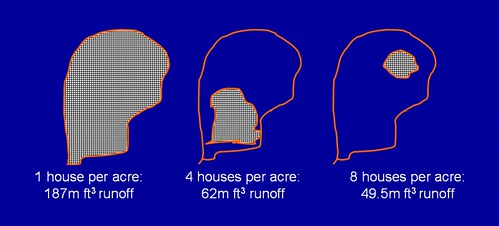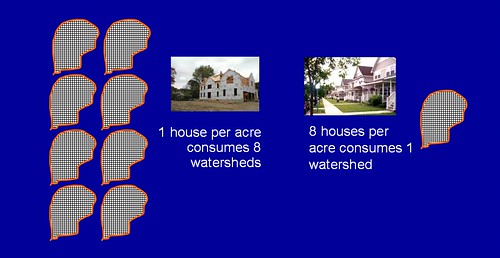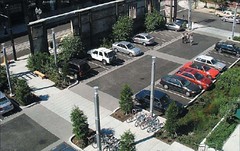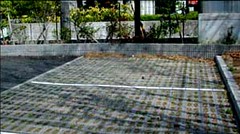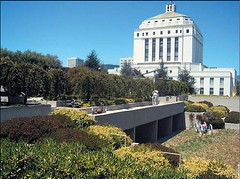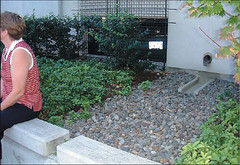How smart growth protects watersheds, and how green infrastructure can make it even better

Posted March 20, 2009 at 1:30PM
I am not an expert on water quality, but I have learned a lot about the subject over the last few years. My tutors have been my NRDC colleagues, my colleagues on the LEED-ND core committee, and the amazing folks at EPA's smart growth office.
Stormwater management is not a straightforward issue in my field, because water advocates typically want to maximize natural systems in a watershed, while we smart growth advocates want to maximize urban development in the places where we do choose to develop. The hard part is that both of us are right. The good news, though, is that the two environmental goals actually can be quite complementary.
One of the keys, as I've written before, is to stop thinking of watershed protection issues on a per-acre, or site-by-site, basis and start thinking of them on a per-capita, or whole-watershed basis. The latter produces eye-opening results. For example, consider these two maps (prepared by Criterion Planners) of the Seattle area, each of which depicts impervious surface (mostly pavement and rooftops), a leading cause of polluted stormwater runoff:
The map on the left shows the amount of impervious surface per acre, the darker areas having more of it. The more densely settled, urban areas are the culprits, right? Not so fast. The map on the right shows the amount of impervious surface per capita, which is actually much higher in outlying areas and lower in urban areas. City dwellers, it turns out, are much more efficient users of the watershed than their sprawling counterparts, and consequently less polluting: the watershed as a whole would have less impervious surface if more of it were densely settled and less of it were sprawling.
The main reason is that sprawl uses more pavement in the form of roadways and parking lots than do compact, walkable neighborhoods. EPA has done some calculations on the subject. Consider a hypothetical, 10,000-acre watershed containing 10,000 houses:
The illustration on the left shows what the watershed might look like at a density of one house per acre; the entire watershed is occupied. The illustration in the middle changes the density to four houses per acre, and the one on the right changes it to eight houses per acre.
You can see that the amount of watershed claimed by the denser development is far less than that claimed by the large-lot configuration. By EPA's calculation, the denser development will produce less than a third of the total runoff that the large-lot development will. This is all grossly simplified, of course, but correct in demonstrating the relative effect of (very moderate, at eight houses per acre) density versus sprawl.
We can extrapolate the same reasoning to a larger scale. If our task were to allocate 80,000 houses across eight 10,000-acre watersheds, doing so at a sprawling configuration of one house per acre occupies all eight of them. But doing so at eight houses per acre would leave seven watersheds untouched:
So, compact development patterns that use land efficiently and build to a walkable scale are the way to go. Smart growth helps protect watersheds in the same way that it reduces greenhouse gas emissions, by using less of a given resource per person than does sprawl.
But we shouldn't stop there. Denser patterns of development, unless mitigated, do create more on-site runoff, on a lot-by-lot basis. So let's mitigate.
The key is green infrastructure. While nosing around EPA's website, I came across a wonderful publication developed by the agency's smart growth office in partnership with the city of Emeryville, California, which is undergoing redevelopment. (Technical work was performed by the firms Community Design + Architecture, Nelson/Nygaard, and Philip Williams Associates.)
The goal was to produce guidelines for "green, dense development." For example, here's a parking lot in Portland:
The photo on the left shows how small green spaces can be integrated into something as mundane and urban as a parking lot, making it not only better functioning for the environment but also more pleasant for drivers and cyclists who use it, as well as for pedestrians and others passing by. The practice softens the urban hardscape while providing ways for stormwater to infiltrate into the ground rather than running off. The photo on the right is a close-up of one of the stalls, showing its pervious pavers, which allow the space to mimic a natural area with regard to stormwater absorption. While such pavers are more fragile than asphalt and would not be as desirable on a heavily traveled roadway, they are fine for this application.
Below, we see a lush green roof in Oakland (left), along with a bio-retention garden adjacent to a building on a busy street (right):
The rooftop garden, which is over the Oakland Museum, looks wonderful, and the bio-retention garden makes for a more pleasant streetscape. Both help absorb stormwater.
There is much, much more in the document, of course, including recommendations for structured, rather than surface, parking; bio-filtration swales in street medians; cisterns incorporated into building architecture; tree preservation; and strategies for more efficient transportation patterns, which minimize the need for paved roadways and parking. Many of these strategies were utilized in the green, dense development Western Harbour in Malmo, Sweden, pictured at the top of this post.
EPA's Lynn Richards was also kind enough to provide me with a copy of a draft scorecard her office is developing for state and local governments to use in protecting water quality while undergoing redevelopment. Lynn refers to the scorecard as "our attempt to try to address water quality protection across multiple scales, mechanisms, and departments," and it is quite sophisticated and thorough. Subjects include:
- Protecting natural resources (including trees) and open space
- Promoting efficient, compact development patterns and infill
- Designing complete, smart streets that reduce overall imperviousness
- Encouraging efficient provision of parking
- Adopting green infrastructure stormwater management provisions
The scorecard, which was introduced earlier this year at the New Partners for Smart Growth conference, is close to final. I'll post a link when it is.


